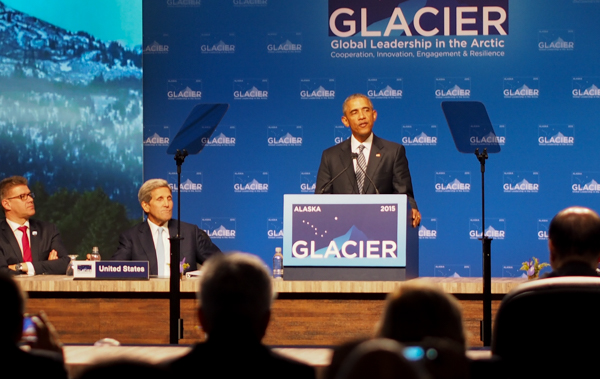
As President Barack Obama continues to visit sites in Alaska during a trip focused on climate change and Arctic policy, reactions are to his speech at the close of the GLACIER conference Monday are still forming. However, a consistent opinion from energy and environmental advocates alike is dissatisfaction.
Nobody seems totally happy with the president’s speech on climate change: too vague, too bleak, goes too far, doesn’t go far enough. Advocates and adversaries of the administration say they just wanted something else.
“Alaska was the backdrop,” said Sen. Lisa Murkowski during a phone interview Tuesday. “His comments were directed to a national, and truly an international, audience.”
Murkowski is critical of the president’s agenda in Alaska for focusing so heavily on climate change, instead of what she believes are more salient local concerns over economic and energy issues.
Regarding the president’s remarks on climate change, Murkowski thinks it isn’t fair to clamor for a green energy future without offering a roadmap to get there.
“How do we get there Mr. President? How do we make this transition?” Murkowski asked. “There has to be a transition plan, and the transition plan cannot be that we price Alaskans out of our economic lifestyle and opportunity here.”
Unsurprisingly, that emphasis on not sacrificing development opportunities is echoed by the energy industry.
Kara Moriarty is president of the Alaska Oil and Gas Association and cites figures from the government’s Energy Information Administration that 80 percent of the nation’s energy will come from fossil fuels for the foreseeable future.
“We are going to continue to rely on oil and gas for the next several decades,” said Moriarty, “and that oil and gas should come from Alaska.”
Like Murkowski, Moriarty thinks Alaska and the nation need to change their relationship with fossil fuels but doesn’t see an immediately viable alternative solution. “Renewables are important,” Moriarty said, “but solar panels and wind turbines–they require a lot of minerals to make those materials.”
For others, though, a lack of particulars in the president’s speech was frustrating for different reasons.
Speaking from Washington, D.C., Cassady Sharp of Greenpeace said environmental advocates are used accustomed to Obama’s convincing words on climate change, matched with frustratingly little follow-through.
“When you match that rhetoric up with the actual actions he’s taking, one: they’re not enough. And then,” Sharp added, “they’re completely undermined when he approves something like Shell’s Arctic drilling plan.”
During the GLACIER conference, members of the administration offered an explanation that Royal Dutch Shell’s Arctic offshore drilling in the Chukchi was approved under President Bush, and this administration has raised standards for permitting and preparedness on it.
But Sharp doesn’t buy it: Obama hasn’t been shy about scrapping programs he disagrees with from past administrations, and yet this one made it all the way to approval.
Even self-professed Obama fans say that when it comes to climate, they haven’t seen the president deliver yet.
“President Obama has done more than any other president before to address the issue of climate change,” said Rick Steiner, a marine conservation biologist based in Anchorage. “The only problem is: it isn’t enough.”
Steiner concedes that the president admitted basically the same thing in his speech, repeating refrains about officials not acting fast or comprehensively enough.
Steiner believes that the Paris climate talks in December need to be where the administration lays out a credible, legally binding plan for curbing emissions by 75 percent in the decades ahead.
But it is a tall order coming to Alaska to pitch measures aimed at slowing climate change. Steiner sees a paradox in how the state has hitched its economic wagon to the same hydrocarbons nibbling away at the shorelines and glaciers. That’s the very reason he sees Alaska as a good place for the administration and state to start scrapping the status quo.
Melanie Bahnke’s opinion of the speech and presidential visit are a bit different. Bahnke is president of the regional non-profit Kawerak in the Bering Strait Region. She was part of the president’s hour-long roundtable with Alaska Native leaders and explained the administration’s work with Alaska Natives and tribal partners has been unprecedented measured against past American presidents. While Obama’s climate speech might not have suited every party’s agenda, Bahnke said, the fact that it’s bringing in actual voices from the communities so often invoked in Alaska’s climate debates means it’s a more holistic approach than what is typically offered.
“He understands that there’s a need to do both: we need to curb and mitigate climate change, but, on the other hand, there are these small coastal villages that are in imminent danger and require urgency and response,” Bahnke said.
Bahnke was part of a small group that met with members of the president’s staff a day after the GLACIER conference to discuss concrete actions that the executive branch can take in the next 15 months before a new administration comes into office.
